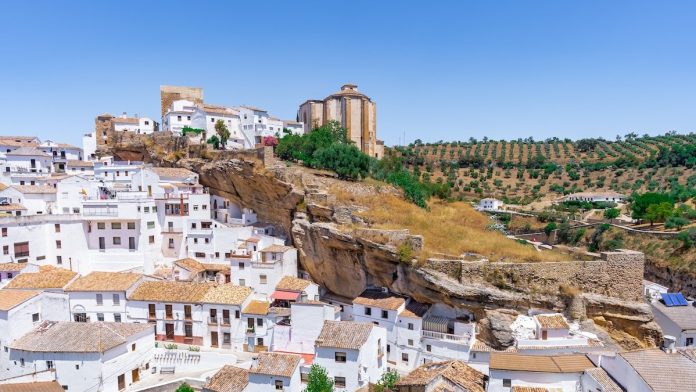Europe is a tourist hotspot. With history lovers heading there for the ancient architecture, art lovers visiting great museums and galleries, foodies dining in top cosmopolitan restaurants, and outdoor lovers mesmerized by fabulous landscapes, there’s something for every type of traveler.
There are a lot of sought-after holiday destinations in Europe, and many of them are indeed worthy of their popularity. But thanks to cheap airfares and influencer’s glamourous Instagram feeds, it can at times seem like every square foot of the continent has already been trampled over, leaving one to wonder if there are any hidden gems in Europe left to explore.
Cities like Paris, Rome, Barcelona, and Amsterdam will always be appealing. However, if you head off the beaten track in Europe, you may well discover somewhere extra special — a place that has all the charm of the popular spots, but without the crowds. With picturesque villages, gorgeous hill towns, seaside resorts, and medieval hamlets among vineyards and lakes, Europe abounds with secret destinations, far from the madding crowds.
There is something rewarding about looking for unexplored and untouched destinations, and every country has some overlooked spots yet to be explored by tourists and travelers. If you get the chance to travel beyond the traditional international tourist “landmarks,” and seek out some of the places that are overlooked, then you definitely should! And thanks to a pretty extensive bus and rail network, I think you’ll find it’s actually not that hard to do.
Let me give you a little inspiration to start you off.
San Marino
Photo credit: Vladimir Sazonov / Shutterstock.com
1. San Marino
Located on the eastern coast of the Italian Peninsula, the pocket-sized nation of San Marino is one of the best-hidden gems in Europe. At 24 square miles, this tiny republic is the third smallest country in Europe (after Vatican City and Monaco), and it’s seriously fascinating.
With an official founding date of September 301 (yes, you read that right, the year 301!) this is the oldest surviving sovereign state and constitutional republic in the world, and its constitution, enacted in 1600, is the world’s oldest constitution still in effect. San Marino is one of the wealthiest countries in the world, with a budget surplus and no national debt.
If you are itching to explore winding cobblestone streets and timeless European charm, then this is the place for you, and you should definitely make time to “pop over the border” from Italy to this micro-state perched high atop a mountain. In fact, with no border formalities, passing from Italy to San Marino is seamless, and foreign visitors can enter without even showing a passport; though if you’d like your passport stamped as a souvenir, there’s a €5 charge.
San Marino’s historic center is a UNESCO World Heritage Site, and if you look up, you’ll see the Three Towers of San Marino, called Cesta, Guaita, and Montale, built between the 13th and 15th centuries, towering above on Monte Titano.
Pro Tip: San Marino is only a 2-hour train trip from Bologna, and 3 hours east of Florence. But don’t listen to those who say to do a day trip — spend at least one night here, and then once the day trippers have left, you’ll really feel like you have the place to yourselves.

Bohinj, Slovenia
Photo credit: Peerayut Buasup / Shutterstock.com
2. Bohinj, Slovenia
Bohinj, Slovenia, nestled in the Julian Alps’ Triglav National Park, one of the oldest National Parks in Europe, is a destination indelibly linked with nature, sustainable development, and unique experiences. Explore on foot, by bike, on horseback, or with skis, visit the town’s three museums, learn about traditional alpine dairy farming and cheese making, try your hand at fly fishing, or visit the international wildflower festival — there’s plenty to see and do here.
The highlight of a trip to Bohinj is Lake Bohinj. Most visitors to Slovenia head straight for Lake Bled, with its tiny island topped with a church, which is indeed stunning. But under 30 minutes away is Lake Bohinj, just as stunning but without the crowds. Think low-hanging mist and mirror-like reflections of the surrounding beautiful snow-covered mountains.
Pro Tip: Bohinj’s ski resort is regarded as one of the best (and best value) in Europe.

Sao Miguel Island
Photo credit: Evgeni Fabisuk / Shutterstock.com
3. São Miguel Island, The Azores, Portugal
The Azores, a nine-island archipelago in the North Atlantic Ocean about 845 miles west of continental Portugal are one of two autonomous regions of Portugal (the other being Madeira). Sao Miguel is the largest of the islands and the best for first-time visitors. Fancy hiking to shimmering crater lakes or bathing in freshwater hot springs or the geothermally active ocean? The islands sit on the junction of three tectonic plates, resulting in beautiful volcanic landscapes.
The beaches are pretty unique too — with some covered in black volcanic sand — and it’s possible to spot whales and swim, responsibly, near dolphins. Aside from all the things to do on Sao Miguel, the food is also incredible, with lots of fresh fish, beef, cheese, and even pineapples. A highlight is Bolo Lêvedo, a fluffy, slightly sweet, Portuguese muffin (they are flat and look a bit like an English muffin).
Pro Tip: The islands are easily accessible from mainland Portugal with lots of flights from Lisbon and Porto. Sao Miguel’s airport also has links to other European countries, as well as the U.S. and Canada.

The Ducal Palace in Mantua, Italy
Photo credit: Massimiliano Pieraccini / Shutterstock.com
4. Mantua, Italy
If you love Italian architecture and art but also love to escape the crowds, then Mantua is for you. While local Italian tourists love visiting Mantua, it seems international tourists are unaware of its existence! Located in the Lombardia region of northern Italy, Mantua is easiest accessed by car, though there are also train connections from Verona, Milan, and Bologna.
Mantua is known for its architectural treasures and artifacts, elegant palaces, and its medieval and Renaissance cityscape. Highlights of a visit include the Ducal Palace (the largest residential building in Europe, after the Vatican, with 600 rooms, grand frescos, and beautiful art), the Te Palace, the Teatro Bibiena, and the Renaissance Basilica di Sant’Andrea. The city is surrounded by three artificial lakes, one covered in lily pads, which is just crying out for a sunset boat cruise.

Perast, Montenegro
Photo credit: Boris Stroujko / Shutterstock.com
5. Perast, Montenegro
Just a 20-minute drive north of Kotor, (one of the most beautiful cities in Montenegro, and also one of the most expensive!), lies the small coastal village of Perast, one of the best-preserved towns on the entire Adriatic coast. With 17 Baroque palaces, 19 churches (the most majestic being St. Nikola Church, a Baroque masterpiece dating back to the 17th century), and barely more than 270 residents and one main street, Perast is a tiny town packed with history and legend.
Add to this its breathtaking location, compact size, and harbor too small for cruise ships, and you have one of the most charming and seemingly untouched destinations in Montenegro. It’s hard to imagine that this tiny town was once a strategic port at the crossroads of the Ottoman Empire and the Venetian Republic.
Pro Tip: Perast is a fantastic spot for seafood lovers, as local fishermen bring their catch straight from the Bay of Kotor and the Adriatic Sea. The oysters and mussels are some of the best in the region.

The town of Mandraki on Nissyros
Photo credit: Karel Gallas / Shutterstock.com
6. Nisyros Island, Greece
The small, quiet island of Nisyros in the south Aegean Sea is best known for its active volcano, with its sulfurous bubbling crater in the middle of the island. Whilst its heart may be volcanic, the island is edged with charming white-washed villages with signature blue framed windows and doors.
For most visitors, Nisyros is a day trip from the resort island of Kos, but if you want to experience a little more of this tiny treasure, you should stay a few nights. Spend a couple of days hiking, swimming at secluded beaches, exploring at your own pace, or drinking Greek coffee along the waterfront as you relax with a book — experience the Greek lifestyle without the crowds of places like Santorini.

Setenil de las Bodegas, Spain
Photo credit: Lyd Photography / Shutterstock.com
7. Setenil De Las Bodegas, Spain
Setenil de las Bodegas is a small town in southern Spain known for its whitewashed houses that are built into the surrounding landscape, providing a stark contrast to the dark cliffs looming above.
Aside from its scenic cliffside setting, Setenil de las Bodegas also boasts a pair of noteworthy attractions. The town’s hilltop castle, Nazari Castle, was once an Arab fortress dating back to the 13th century. The medieval castle was one of the last Moorish strongholds before the Christians retook the Iberian Peninsula in the late 1400s. All but one of the castle’s original towers were demolished after the final siege, but it’s still worth making a stop here for the incredible views of the town below.
The second spot to visit is the Church of La Encarnación. While this may not be the most extravagant of churches in Spain, it’s still special in its own right. Built in 1505 on the orders of the Archbishop of Seville, the church was built over the old Arab mezquita, as was the custom in those days, and is still in use today, providing a glimpse of what life used to be like in small Spanish villages.
Tucked between Sevilla and Granada, Setenil de las Bodegas is one of Andalusia’s best-kept secrets. It’s amazing the town has managed to stay under the radar for so long.

Novalja on the island of Pag in Croatia
Photo credit: Ilija Ascic / Shutterstock.com
8. Pag Island, Croatia
Pag Island is one of the 1,200 Croatian islands in the Adriatic Sea — which may go some way to explaining how it’s managed to keep such a low profile. Unlike other Croatian islands, which tend to be tropical and covered with dense vegetation, Pag Island, often referred to as “the moonrock,” is a barren, rocky landscape.
There are no rivers and trees, instead, it has an arid landscape covered with white stones and lots of salt. The island itself is surrounded by the clear, brilliant blue Adriatic, and secluded coves and beaches surround the island. Top beaches include Zrce Beach, Strasko Beach, and Spiaggia di Rucica. Sunrise and sunset here are some of the finest and most magical you’ll ever see.
Perhaps oddly, alongside all this island beauty, culture, and history, the northern part of Pag Island is known for its nightlife scene, and Pag Island’s party hub of Zrće beach has become a festival and clubbing destination to rival any party spot in the world. The south meanwhile remains much more quiet and serene.
In addition to all this, Pag Island is also famed for its sheep milk cheese (Paški sir) and is widely considered home to the best artisan cheese, olive oils, and wines in Croatia, as well as being the origin of Pag lace, a centuries-old tradition that was started by the Benedictine nuns of the St. Margaret convent.
Go Off The Track
And there you have a few of my recommendations to start you off on your European “off the beaten track” travels. Remember, as American academic and author Susan Magsamen once said, “Look for chances to take the less-traveled roads. There are no wrong turns.” Happy exploring!
For more on Europe, explore these articles:
Unlock the world’s wonders with unforgettable journeys tailored just for you! Whether you crave sun-kissed beaches, thrilling adventures, or rich cultural escapes, your dream destination awaits. Enjoy seamless travel with expert tips, exclusive deals, and handpicked experiences that Turn Every Trip into a lifetime memory.










